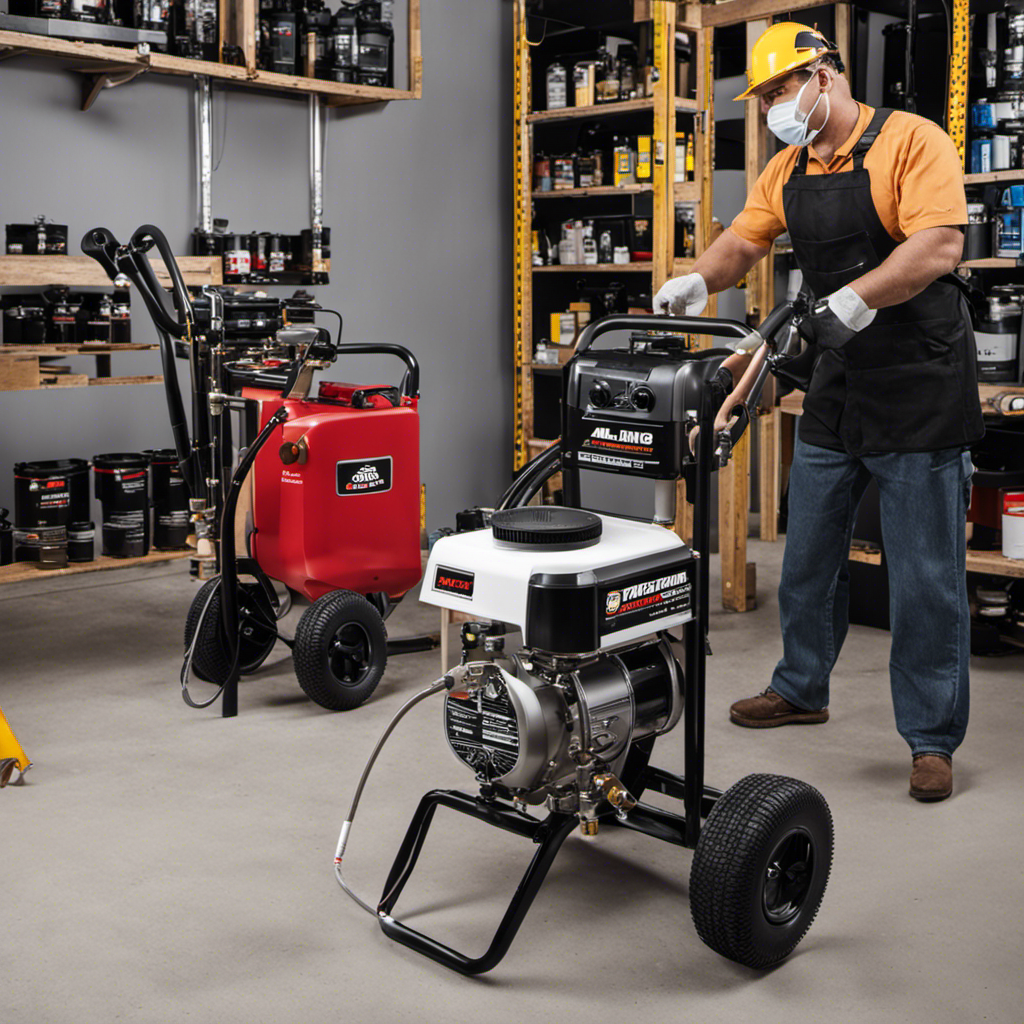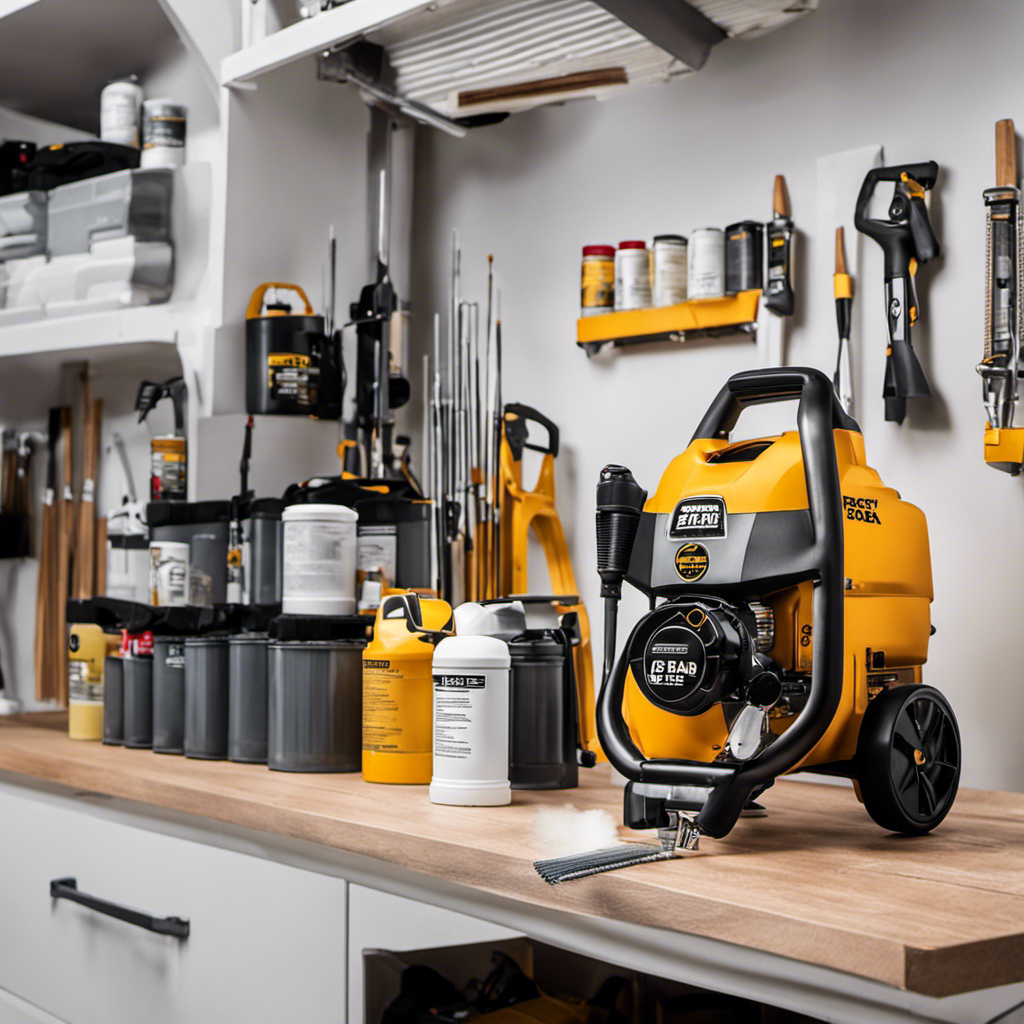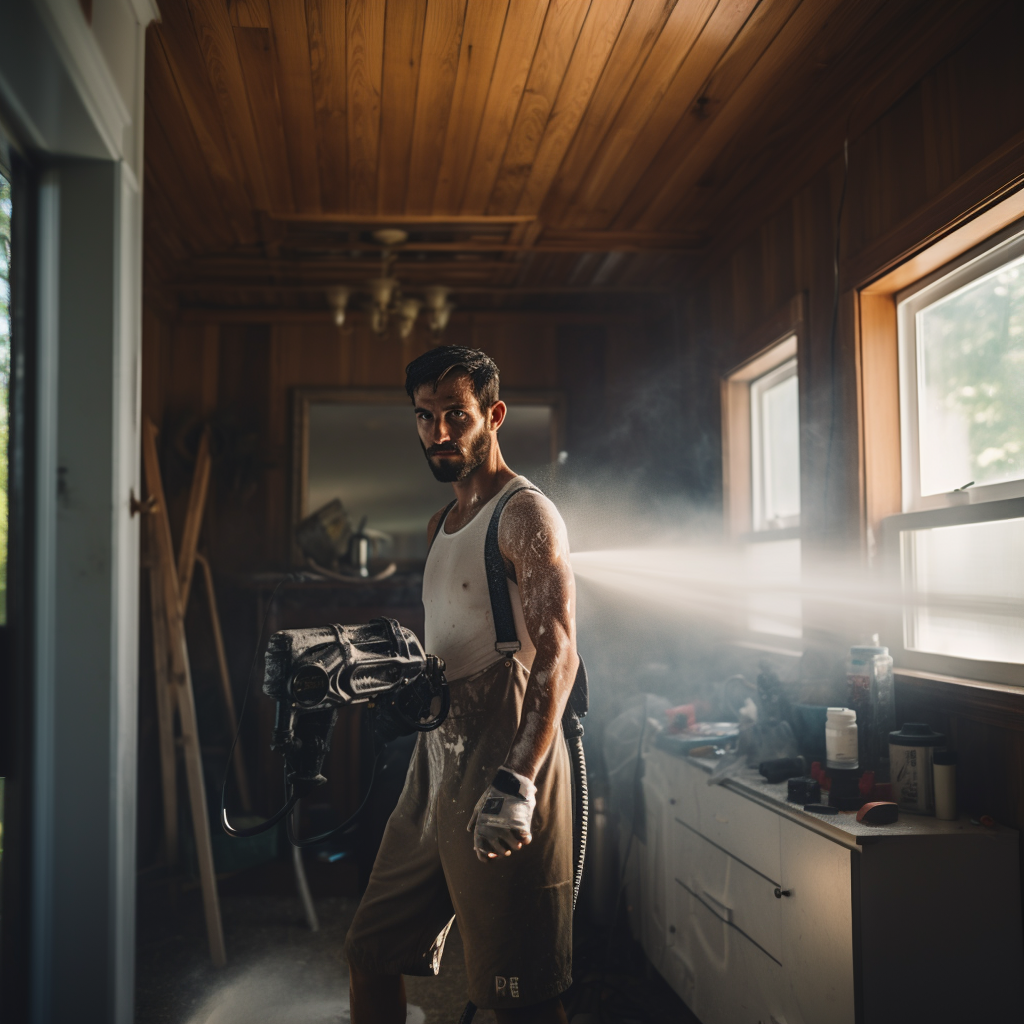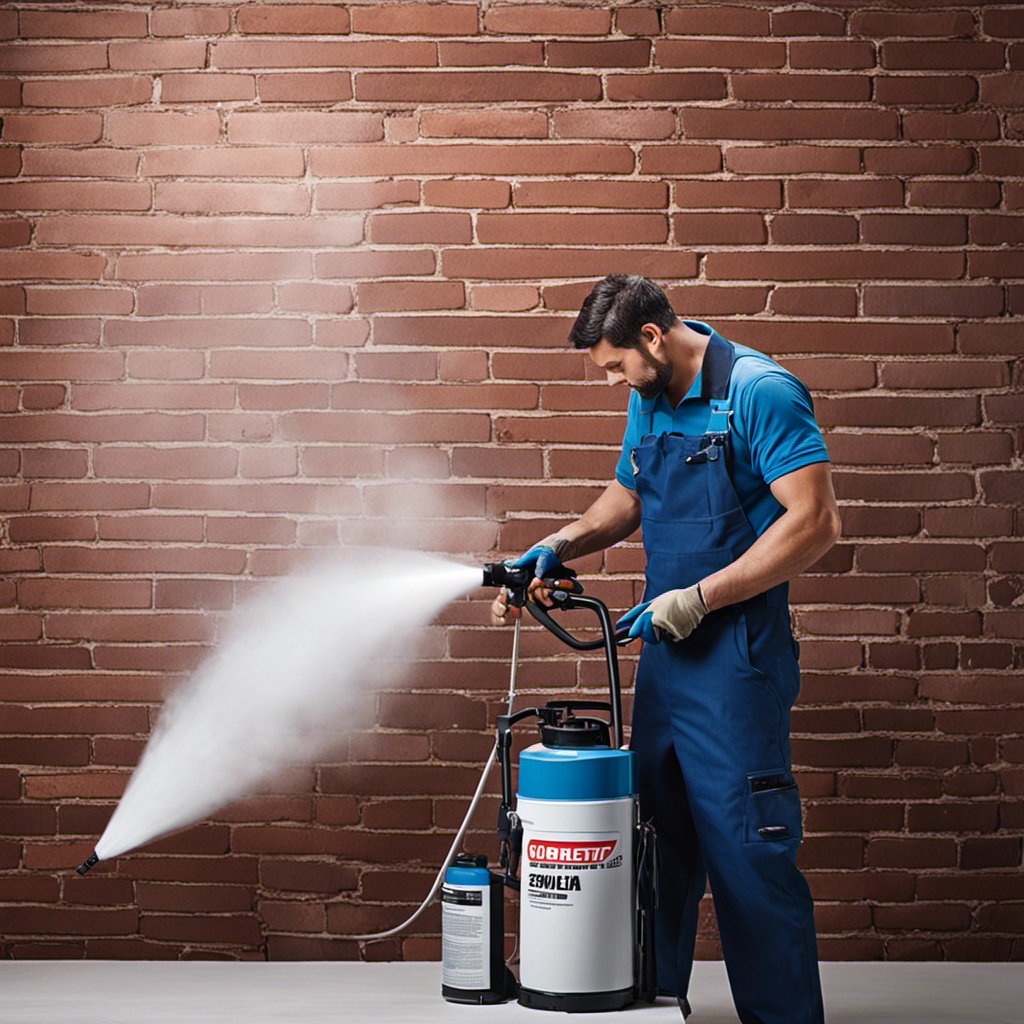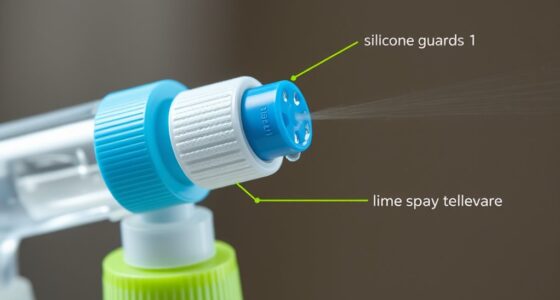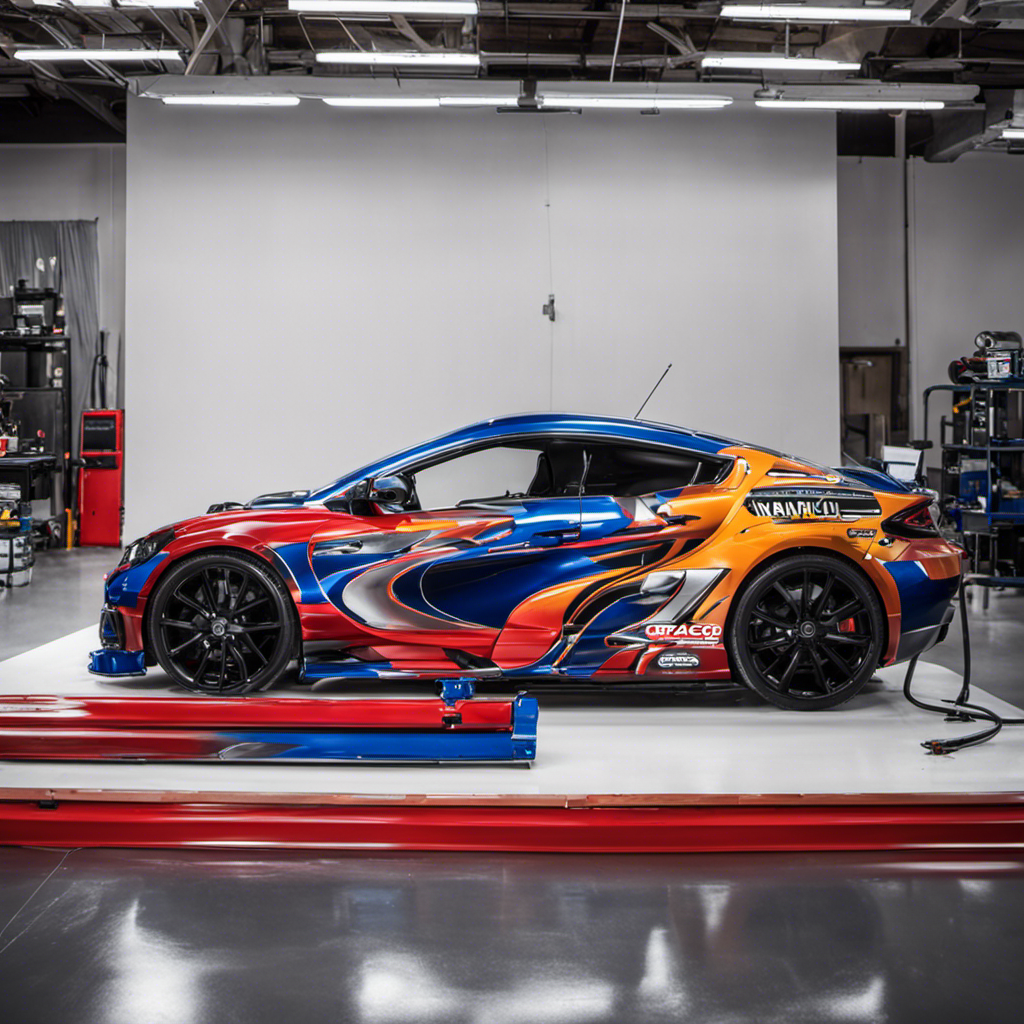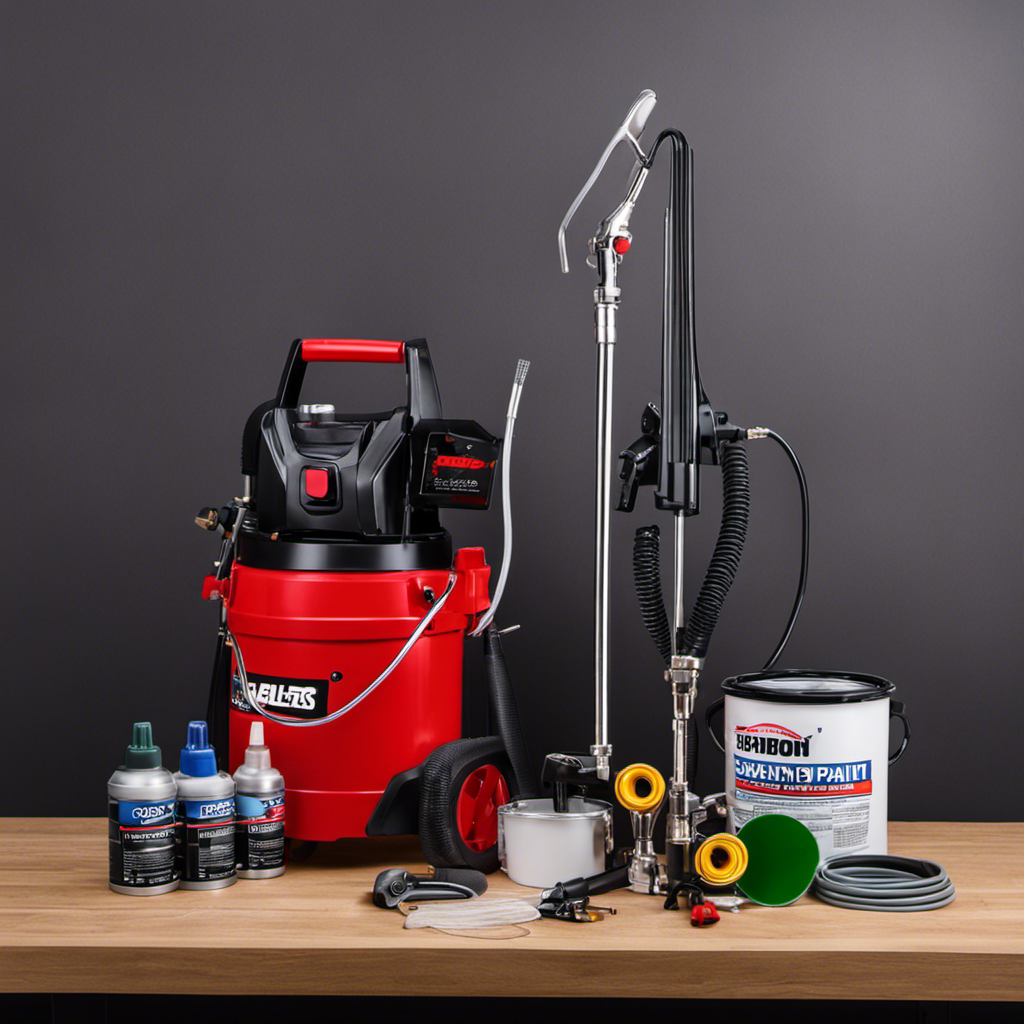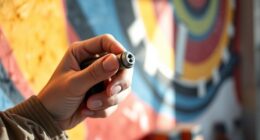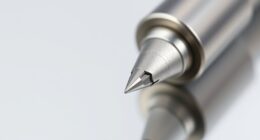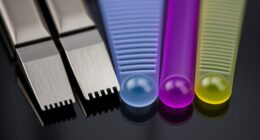When engaging in painting projects, selecting the correct airless paint sprayer is crucial and can significantly impact the end outcome. With a variety of options available, it is essential to choose wisely.
In this article, we explore the various types of airless paint sprayers and their pros and cons, as well as the ideal uses for HVLP (High Volume Low Pressure) technology. From cart-mounted to handheld, piston pump to diaphragm pump, we’ll delve into the details to help you make an informed decision.
So sit back, relax, and let us guide you through the world of airless paint sprayers.
Key Takeaways
- There are various types of airless paint sprayers, including cart-mounted, handheld, piston pump, diaphragm pump, and battery-powered/gas-powered.
- HVLP technology offers reduced overspray and more controlled application, making it ideal for precision projects and painting furniture or intricate designs.
- HVLP technology is easier to clean and maintain compared to airless paint sprayers, but it has a lower production rate and requires more skill and technique.
- Cart-mounted airless paint sprayers are highly portable and have a larger capacity, while handheld airless paint sprayers are compact, lightweight, and perfect for small projects or touch-ups.
Types of Airless Paint Sprayers
The types of airless paint sprayers include cart-mounted, handheld, piston pump, diaphragm pump, battery-powered, and gas-powered sprayers. Each type has its own unique features and benefits that make them suitable for different airless paint sprayer applications.
Cart-mounted airless paint sprayers are highly portable and easy to maneuver, making them ideal for larger projects that require a higher production rate. They have a larger capacity and are more stable due to the cart, but they may not be suitable for tight spaces or narrow areas.
Handheld airless paint sprayers, on the other hand, are compact and lightweight, making them perfect for smaller painting projects or touch-ups. They are not as efficient or powerful as larger sprayers, but they are great for quick and precise painting tasks.
Overall, airless paint sprayers offer numerous benefits such as reduced overspray, more even and controlled application, and easier cleaning and maintenance. They are suitable for a wide range of surfaces and can work well with both water-based and oil-based paints.
Pros and Cons of HVLP Technology
HVLP technology offers several benefits and limitations compared to airless paint sprayers. The primary advantages of HVLP technology include reduced overspray, more even and controlled application, and easier cleaning and maintenance. However, it also has some limitations, such as a lower production rate and the need for a higher level of skill and technique. To better understand the differences between HVLP and airless paint sprayers, let’s compare them in a table:
| HVLP Technology | Airless Paint Sprayers |
|---|---|
| Reduced overspray | Higher overspray |
| More even and controlled application | Less control over application |
| Easier cleaning and maintenance | More complex cleaning and maintenance |
While HVLP technology is ideal for smaller projects that require precision and a high-quality finish, airless paint sprayers are better suited for larger projects with faster coverage. Ultimately, the choice between HVLP and airless paint sprayers depends on the specific requirements and preferences of the user.
Ideal Uses of HVLP Technology
When considering painting projects that require precision and a high-quality finish, HVLP technology is often the preferred choice. HVLP stands for High Volume Low Pressure, and it utilizes a turbine to generate a high volume of air at a low pressure, resulting in a controlled and even application of paint.
HVLP technology is especially well-suited for precision projects that require attention to detail, such as painting furniture, cabinets, or intricate designs. The fine mist of paint produced by HVLP sprayers ensures an even coat without excessive overspray, making it ideal for water-based paints.
Additionally, HVLP sprayers are compatible with a wide range of surfaces, allowing for quick and efficient coverage on various materials.
Cart-Mounted Airless Paint Sprayers
Cart-mounted airless paint sprayers provide convenience and stability with their highly portable and maneuverable design. These sprayers are equipped with a cart that allows for easy transportation and storage, making them ideal for larger painting projects. The cart also adds stability, reducing the risk of tipping over during operation.
One of the advantages of cart-mounted airless paint sprayers is their larger capacity, allowing for longer painting sessions without the need for frequent refills. This can be particularly beneficial for professional painters or those tackling extensive projects.
However, there are also some disadvantages to consider. Cart-mounted airless paint sprayers may not be suitable for tight spaces or narrow areas due to their larger size. Additionally, navigating these sprayers on uneven surfaces can be more challenging compared to handheld models.
Overall, cart-mounted airless paint sprayers offer convenience and stability, but their size and maneuverability limitations should be taken into account when choosing the right sprayer for a specific project.
Handheld Airless Paint Sprayers
Handheld airless paint sprayers offer a compact and lightweight design, making them suitable for smaller painting projects or touch-ups. These portable devices are known for their efficiency and ease of use. Here are three key features that highlight their portability and efficiency:
-
Compact Design: Handheld airless paint sprayers are designed to be small and easy to handle. Their compact size allows for easy maneuverability, especially in tight spaces or narrow areas.
-
Lightweight Construction: These sprayers are made with lightweight materials, making them comfortable to hold and use for extended periods. The reduced weight also contributes to their overall portability.
-
Quick and Precise Painting: Despite their smaller size, handheld airless paint sprayers are still capable of delivering a consistent and even coat of paint. They offer quick and efficient coverage, making them perfect for professionals and DIY enthusiasts who value speed and precision.
With their portability and efficiency, handheld airless paint sprayers are a great choice for small painting projects or touch-ups.
Tips for Choosing the Right Airless Paint Sprayer
Compact and lightweight design is one of the key factors to consider when selecting an airless paint sprayer. These portable sprayers offer convenience and ease of use, making them ideal for smaller painting projects or touch-ups.
However, it’s important to also consider other factors before making a purchase. Factors to consider include the type of sprayer, such as cart-mounted or handheld, and the ideal uses of the sprayer, such as precision work or quick coverage.
Key features to look for in an airless paint sprayer include the capacity, stability, and maneuverability for cart-mounted sprayers, and the efficiency and power for handheld sprayers.
Frequently Asked Questions
Are Airless Paint Sprayers Suitable for Both Indoor and Outdoor Painting Projects?
Airless paint sprayers are suitable for both indoor and outdoor painting projects. They offer numerous benefits, such as faster application and a more even coat of paint.
Whether it’s painting walls, ceilings, or exterior surfaces like fences or decks, airless sprayers can handle the job efficiently. They are also versatile, working well with different types of paints.
With their powerful and precise spray, airless paint sprayers are a great choice for any painting project, both inside and outside the house.
Can HVLP Technology Be Used for Painting Textured Surfaces?
HVLP technology can be used for painting textured surfaces with the right techniques.
When using HVLP technology on rough surfaces, there are a few tips to keep in mind.
First, it is important to choose the right nozzle size for the texture of the surface. A larger nozzle size can help ensure better coverage.
Second, it is recommended to thin the paint slightly to improve flow and prevent clogging.
Lastly, taking the time to properly prepare the surface by sanding and cleaning it will help achieve a smoother finish.
How Long Does It Take for the Paint to Dry When Using an Airless Paint Sprayer?
The paint drying time when using an airless paint sprayer can vary depending on several factors. These factors include the type of paint used, humidity levels, temperature, and the thickness of the paint application.
Generally, it can take anywhere from a few hours to a full day for the paint to dry completely. However, it’s important to note that some paints may require longer drying times for optimal results.
Is It Necessary to Thin the Paint Before Using an Airless Paint Sprayer?
It is necessary to thin the paint before using an airless paint sprayer. Thinning the paint helps to achieve a more even and controlled application, reduces clogging in the sprayer, and improves the overall performance of the equipment.
Proper paint thinning also helps to extend the life of the sprayer by preventing build-up and clogging. It is important to follow the manufacturer’s recommendations for paint thinning and to clean the sprayer thoroughly after each use to ensure proper airless paint sprayer maintenance.
Can Airless Paint Sprayers Be Used With Other Types of Coatings, Such as Stains or Varnishes?
Airless paint sprayers can be used with other types of coatings, such as stains or varnishes. They are commonly used for automotive finishes and are highly effective in applying multiple coats.
With their powerful spraying capabilities, airless paint sprayers ensure a smooth and even application, making them suitable for a wide range of projects.
Whether it’s for professional use or DIY enthusiasts, airless paint sprayers offer convenience, efficiency, and versatility in achieving high-quality finishes.
Conclusion
In conclusion, when it comes to choosing the right airless paint sprayer, it is important to consider the specific needs of your project.
Whether you opt for a cart-mounted or handheld sprayer, a piston or diaphragm pump, or even a battery-powered or gas-powered option, each type has its own advantages and disadvantages.
However, if you are looking for precision, control, and a high-quality finish, HVLP technology is the way to go. With reduced overspray and easy maintenance, it offers a consistent and even coat of paint.
So, whether you’re tackling a small project or a larger surface, make sure to choose the airless paint sprayer that will best meet your needs and bring your vision to life.
Franz came aboard the Paint Sprayer Zone team with a background in both journalism and home renovation. His articulate writing style, combined with a passion for DIY projects, makes him an invaluable asset. Franz has a knack for breaking down technical jargon into easy-to-understand content, ensuring that even the most novice of readers can grasp the complexities of paint sprayers.
